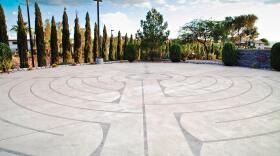February is just around the corner, and that means it’s pruning time. Of all the tools in your garden arsenal, hand pruners are the most important investment. Don’t skimp on these; a good pair can last a lifetime -- and a cheap pair will make your hand ache and hurt the plants you’re trying to help. Get by-pass pruners, the kind with a scissor-type action, where the blades move past each other to make a clean cut. Avoid anvil types, which have a straight blade that comes down on a flat anvil and stops, “bruising” the wood along the way. Felco used to be my favorite hand-pruners, though I switched to a Bahco hand pruner a couple of years ago, as it fit me well and took less pressure to make the same cut.
Tip: Keep the blade sharp. Use a fine file to lightly run it across the cutting knife, in line with the face of the blade that is angled in. Don’t run it across the backside of the cutting knife, nor on the other, thicker blade. Also clean and lube them periodically.
Pocket saws. If my hand pruners can’t handle the cut, the saw comes out. I use mine for all cuts greater than - inch. A quality pocket saw can handle cutting branches up to 3 or 4 inches in diameter and can even prune through wood as much as 6 inches around.
Why a saw and not a lopper, which many people prefer? Because every cut made on living tissue is a wound and, just like you’d want a doctor to make precise cuts if he were to operate on you, the same holds true for your “patient.” A saw makes such a cut by removing wood in small, precise quantities with each stroke. Loppers use brute force to push the blade through tissue, bruising and damaging it. A good pocket saw will run you about $24-$30. I’ve used a Felco 600 folding saw for many years, but other brands are just as good.
Tips: Make sure the saw has a mechanism that locks the blade in place. To keep the blade sharp, keep your saw-blade out of the dirt. Nothing dulls a saw quicker that running it through soil. For root-pruning, keep an old saw or saw-blade around, or use hand-pruners for smaller cuts.
Loppers. While I don’t use them to prune my plants and trees, loppers are still an important part of my arsenal. They’re handy for cutting up larger branches already removed to stuff them into garbage cans or to take the weight off of a branch prior to making a final cut with the saw.
When choosing loppers, I want the same scissors-type cutting action; I also seek out longer handles, which give more torque and power. I have loppers built by a company called Fred Marvin I bought for more than $40 several years ago. Solidly engineered, they do an amazing job of slicing through fresh wood up to 1-inch diameter. Bahco also makes very good loppers and other pruning equipment. Remember, though, quality counts, but so does care: With proper maintenance and sharpening, they’ll last a lifetime – Norm Schilling
Norm Schilling is owner of Schilling Horticulture Group in Las Vegas. He also gives gardening advice in his “Desert Bloom” segments on News 88.9 KNPR.
Love your bugs
There’s an adage, “The only good bug is a dead bug.” I couldn’t disagree more. There are lots of good bugs I want in my garden, and I want them alive and well. Biological diversity creates biological balance. In fact, I’ve learned that the less I use pest control, the fewer pest problems I have. Of course, sometimes you have to go into battle. Here are some typical cases — and some low-impact, earth-friendly methods I recommend.
Caterpillars: If there are too many to pick off and feed to the chickens, I use BT, a naturally occurring bacteria that mostly only affects caterpillars, and is available at nurseries and hardware stores.
Spider mites: These tiny pests weave small webs and give a plant a dusty look. To control, I use blasts of pressurized water (just a nozzle on my hose). The wet, humid conditions also discourage mating. On more severe infestations, I spray soapy water. This is even more effective, but also kills any predators it might hit.
Agave weevil: Here’s where I bring out the heavy artillery. These insects eat the root systems of my agaves and by the time I can see the signs of damage, it’s usually too late! So, I treat proactively, using a systemic insecticide called Bayer Tree and Shrub Insecticide.
Leaf-footed bugs: These bugs are especially well-known for damaging pomegranates. To control, apply a food-grade diatomaceous earth (available under the brand name “Die-Bug”) when you see signs of the insect.
Aphids: Don’t treat! Most plants can handle lots. Think of them as welcome treats for the predators. Plants like yuccas and red yucca can have their entire flowers covered in them, without the plant suffering any significant ill-effect. Aphids are the meat and potatoes of the bug world — so leave the feast for the good bugs in your yard. — N.S.
Can you dig it?
The one part of the Lesche digging tool that DID break down, after about five years of nearly daily wear and use, is the sheath. I hopped online and easily found a site where I could order just the sheath for $12.25. Whatever kind of trowel you get, avoid the common pot-metal or thin-steel varieties of digging trowels. The pot-metal breaks easily and the thin steel bends in our rocky and hard soils, rendering them both almost useless. — N.S.








